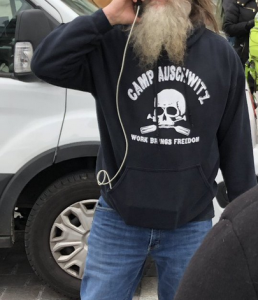The Nancy & David Wolf Holocaust & Humanity Center released a statement this week regarding the mob attack at the Capitol. In THE STATEMENT, WE SAID:
“History teaches us that democracy is fragile, and today we are reminded of that.
Yesterday’s mob attack and brazen displays of violence were an assault on democracy and fueled by hate. We witnessed a rioter wearing a “Camp Auschwitz” sweatshirt invade the halls of the U.S. Capitol while crowds outside brandished flags with Confederate and white supremacist symbols, including Swastikas, on them.”
There are many symbols used by a variety of white supremacist groups and movements, as well as some other types of hate groups. This week, we saw a grotesque variety of antisemitic displays by rioters. Some antisemitic symbols are more overt than others. Here is a breakdown of what some of them mean:
Camp Auschwitz Shirt
“A photo of the man wearing the sweatshirt was just one of the images of hateful symbols that have circulated from the mob, whose violence led to four deaths and wreaked havoc on Congress. Swastikas and Confederate flags were among the overt hate signs that the insurrection brought into the Capitol,” HEY ALMA, a news publication for Jewish millennials, reported.
The sweatshirt read: “Camp Auschwitz,” along with the message “Work brings freedom.” The back of the shirt said “Staff.”

Proud Boys
Multiple Proud Boys, and group-affiliated symbols, were seen at the protests on Wednesday. The Proud Boys represent an unconventional strain of American right-wing extremism. While the group can be described as VIOLENT, NATIONALISTIC, ISLAMOPHOBIC, TRANSPHOBIC AND MISOGYNISTIC, its members represent a range of ethnic backgrounds, and its leaders vehemently protest any allegations of racism. Their founder, Gavin McInnes, went so far as to file a DEFAMATION LAWSUIT against the Southern Poverty Law Center when the SPLC designated the Proud Boys a hate group, according to the ADL. Read MORE.
QAnon slogans
“Q” REPRESENTS the purported high-ranking government official who shares inside information with QAnon followers through cryptic posts on fringe websites. QAnon followers often wear T-shirts emblazoned with a huge Q — and several of them were part of the Capitol mob, ACCORDING TO HEY ALMA. TWITTER banned on Friday the accounts of GEN. MICHAEL FLYNN, lawyer SIDNEY POWELL and a host of other supporters of THE BOGUS QANON CONSPIRACY THEORY embraced by many of President Donald Trump’s most avid fans. Read MORE HERE.
I wrote about the significance of Jake “Q Shaman” Angeli’s Norse pagan tattoos and the co-option of ancient pagan symbols by white supremacists for @RollingStone https://t.co/rw5LEvWWbZ
— Kim Kelly (@GrimKim) January 8, 2021
Crusader Crosses
“The shooter who committed the 2019 MASSACRE at a New Zealand mosque APPROPRIATED symbols of the Crusades, and they’ve become popular with other far-right, ethnonationalist groups. The symbols, such as medieval-style helmets or TEMPLAR AND CRUSADER CROSSES, are meant to harken to an era of white, Christian wars against Muslims and Jews,” Hey Alma REPORTED.
Swastikas
Swastikas were reportedly seen on flags and other messaging during the mob attack at the Capitol. According to the ADL, “the swastika is an ancient symbol that emerged independently among many cultures on several continents. Before the 20th century, its use (including in the United States) was almost always benign. Even today, the swastika is a common symbol across Asia, used by Hindus, Buddhists, and adherents of other religions, where it is often associated with good fortune.
However, in the early 20th century, various right-wing adherents of the so-called “völkisch” movement in Germany, a movement in large part dedicated to uncovering a romanticized and largely mythical German/“Aryan” past, adopted the swastika as a symbol. The use of the swastika in this context subsequently influenced Adolf Hitler to adopt the swastika as the primary symbol for the Nazi Party in 1920. The murderous legacy of the Nazi regime, especially the Holocaust, permanently converted the swastika into a symbol of hate, antisemitism and infamy.” READ MORE.
You can learn more ABOUT HATE AND ANTISEMITIC SYMBOLS ONLINE. This database provides an overview of many of the symbols most frequently used by a variety of white supremacist groups and movements, as well as some other types of hate groups.
